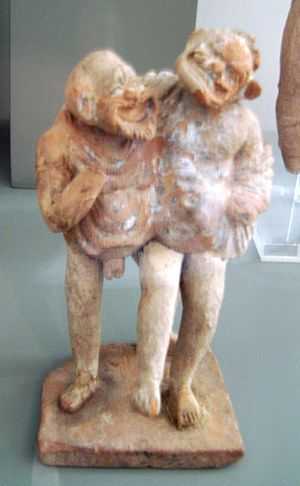Fabula palliata

Terra cotta representation of two comic actors wearing masks with pallia slung over their shoulders.
The name comes from the pallium, a small cape traditionally worn by the actors who performed in this type of play, in imitation of the himation worn by Greek actors.[1]
Definition and history of the concept
Knowledge of the genre comes from a 1st-century BC literary critic named Volcacius Sedigitus, of whom nothing is known except his report in Aulus Gellius.[2] Of the writers whose works have survived at all Sedigitus identifies as well Naevius, Plautus, Ennius, Caecilius and Terence as contributors to the genre. In addition were Licinius, Atilius, Turpilius, Trabea and Luscius Lanuvius.
Notes
- ↑ "Fabula palliata". Britannica Online Encyclopedia. Retrieved 17 October 2009.
- ↑ Smith, William; Anthon, Charles (July 9, 2006). A new classical dictionary of Greek and Roman biography, mythology and geography 2. Kessinger. p. 794. ISBN 978-1-4286-4561-5.
Sedigĭtus, Volcātĭus, from whose work De Poētis A. Gellius (xv., 24) has preserved iambic senarians, in which the principal Latin comics are enumerated in order of merit.
References
- G. E. Duckworth (1952). The Nature of Roman Comedy. Princeton University Press.
- C. W. Marshall (2006). The Stagecraft and Performance of Roman Comedy. Cambridge University Press. ISBN 0521861616.
External links
- Lefèvre, Eckard (2003/04). "Asides in New Comedy and the Palliata" (pdf). Leeds International Classical Studies 3 (3). ISSN 1477-3643. Check date values in:
|date=(help)